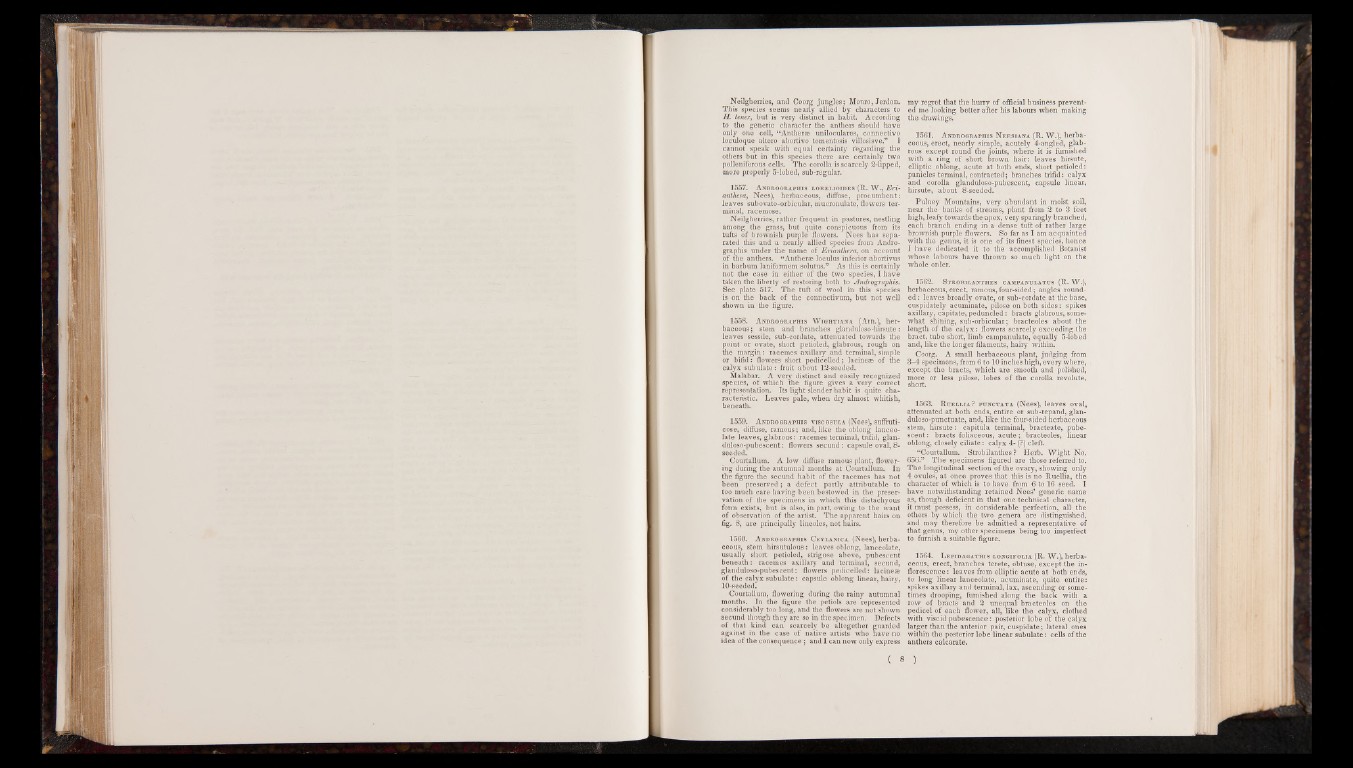
Neilgherries, and Coorg jungles; Monro, Jerdon.
This species seems nearly allied by characters to
H. tuner, but is very distinct in habit. According
to the generic character the anthers should have
only one cell, “Anther® uniloculares, connectivo
loculoque altero abortivo tomentosis villosisve.” I
cannot speak with equal certainty regarding the
others but in this species there are certainly two
polleniferous cells. The corolla is scarcely 2-lipped,
more properly 5-lobed, sub-regular.
1557. Andrographis lobelioides (R. W., Eri-
anthera, Nees), herbaceous, diffuse, procumbent:
leaves subovato-orbicular, mucronulate, flowers terminal,
racemose.
Neilgherries, rather frequent in pastures, nestling
among the grass, but quite conspicuous from its
tufts of brownish purple flowers. Nees has separated
this and a nearly allied species from Andrographis
under the name of Erianthera, on account
of the anthers. “Antheras loculus inferior abortivus
in barbum laniformem solutus.” As this is certainly
not the case in either of the two species, I have
taken the liberty of restoring both to Andrographis.
See plate 517. The tuft of wool in this species
is on the back of the connectivum, but not well
shown in the figure.
1558. Andrographis Wightiana (Am.), herbaceous
; stem and branches glanduloso-hirsute:
leaves sessile, sub-cordate, attenuated towards the
point or ovate, short petioled, glabrous; rough on
the margin: racemes axillary and terminal, simple
or bifid: flowers short pedicelled; lacineas of the
calyx subulate: fruit about 12-seeded.
Malabar. A very distinct and easily recognized
species, of which the figure gives a very correct
representation. Its light slender habit is quite characteristic.
Leaves pale, when dry almost whitish,
beneath.
1559. Andrographis yiscosula (Nees), suffruti-
cose, diffuse, ramous; and, like the oblong lanceolate
leaves, glabrous: racemes terminal, trifid, glanduloso
pubescent : flowers secund: capsule oval, 8-
seeded.
Courtallum. A low diffuse ramous plant, flowering
during the autumnal months at Courtallum. In
the figure the secund habit of the racemes has not
been preserved; a defect partly attributable to
too much care having been bestowed in the preservation
of the specimens in which this distachyous
form exists, but is also, in part, owing to the want
of observation of the artist. The apparent hairs on
fig. 8, are principally lineoles, not hairs.
1560. Andrographis Ceylanica (Nees), herbaceous,
stem hirsutulous: leaves oblong, lanceolate,
usually short petioled, strigose above, pubescent
beneath: racemes axillary and terminal, secund,
glanduloso-pubescent: flowers pedicelled: lacineas
of the calyx subulate: capsule oblong linear, hairy,
10-seeded.
Courtallum, flowering during the rainy autumnal
months. In the figure the petiols are represented
considerably too long, and the flowers are not shown
secund though they are so in the specimen. Defects
of that kind can scarcely be altogether guarded
against in the case of native artists who nave no
idea of the consequence; and I can now only express
my regret that the hurry of official business prevented
me looking better after his labours when making
the drawings.
1561. Andrographis Neesiana (R. W.), herbaceous,
erect, nearly simple, acutely 4-angled, glabrous
except round the joints, where it is furnished
with a ring of short brown hair: leaves hirsute,
elliptic oblong, acute at both ends, short petioled:
panicles terminal, contracted ; branches trifid: calyx
and corolla glanduloso-pubescent, capsule linear,
hirsute, about 8-seeded.
Pulney Mountains, very abundant in moist soil,
near the banks of streams, plant from 2 to 3 feet
high, leafy towards the apex, very sparingly branched,
each branch ending in a dense tuft of rather' large
brownish purple flowers. So far as I am acquainted
with the genus, it is one of its finest species, hence
I have dedicated it to the accomplished Botanist
whose labours have thrown so much light on the
whole ordér.
1562. Strobilanthes campanulatus (R. W.),
herbaceous, erect, ramous, four-sided ; angles rounded
: leaves broadly ovate, or sub-cordate at the base,
cuspidately acuminate, pilose on both sides : spikes
axillary, capitate, peduncled : bracts glabrous, somewhat
shining, sub-orbicular; bracteoles about the
length of the calyx: flowers scarcely exceeding.the
bract, tube short, limb campanulate, equally 5-lobed
and, like the longer filaments, hairy within.
Coorg. A small herbaceous plant, judging from
3 -4 specimens, from 6 to 10 inches high, every where,
except the bracts, which are smooth and polished,
more or less pilose, lobes of the corolla revolute,
short.
1563. Rueli.ia? punctata (Nees), leaves oval,
attenuated at both ends, entire or sub-repand, glan-
duloso-punctuate, and, like the four-sided herbaceous
stem, hirsute : capitula terminal, bracteate, pubescent
: bracts foliaceous, acute ; bracteoles, linear
oblong, closely ciliate: calyx 4- (?) cleft.
“Courtallum. Strobilanthes ? Herb. Wight No.
656.” The specimens figured are those referred to.
The longitudinal section of the ovary, showing only
4 ovules, at once proves that this is no Ruelua, the
character of which is to have from 6 to 16 seed. I
have notwithstanding retained Nées’ generic name
as, though deficient in that one technical character,
it must possess, in considerable perfection, all the
others by which the two genera are distinguished,
and may therefore be admitted a representative of
that genus, my other specimens being too imperfect
to furnish a suitable figure.
1564. Lepidagathis longifolia (R. W.), herbaceous,
erect, branches terete, obtuse, except the inflorescence
: leaves from elliptic acute at both ends,
to long linear lanceolate, acuminate, quite entire:
spikes axillary and terminal, lax, ascending or sometimes
drooping, furnished along the back with a
row of bracts and 2 unequal bracteoles on the
pedicel of each flower, all, like the calyx; clothed
with viscid pubescence : posterior lobe of the calyx
larger than the anterior pair, cuspidate; lateral ones
within the posterior lobe linear subulate : cells o f the
anthers calcarate.